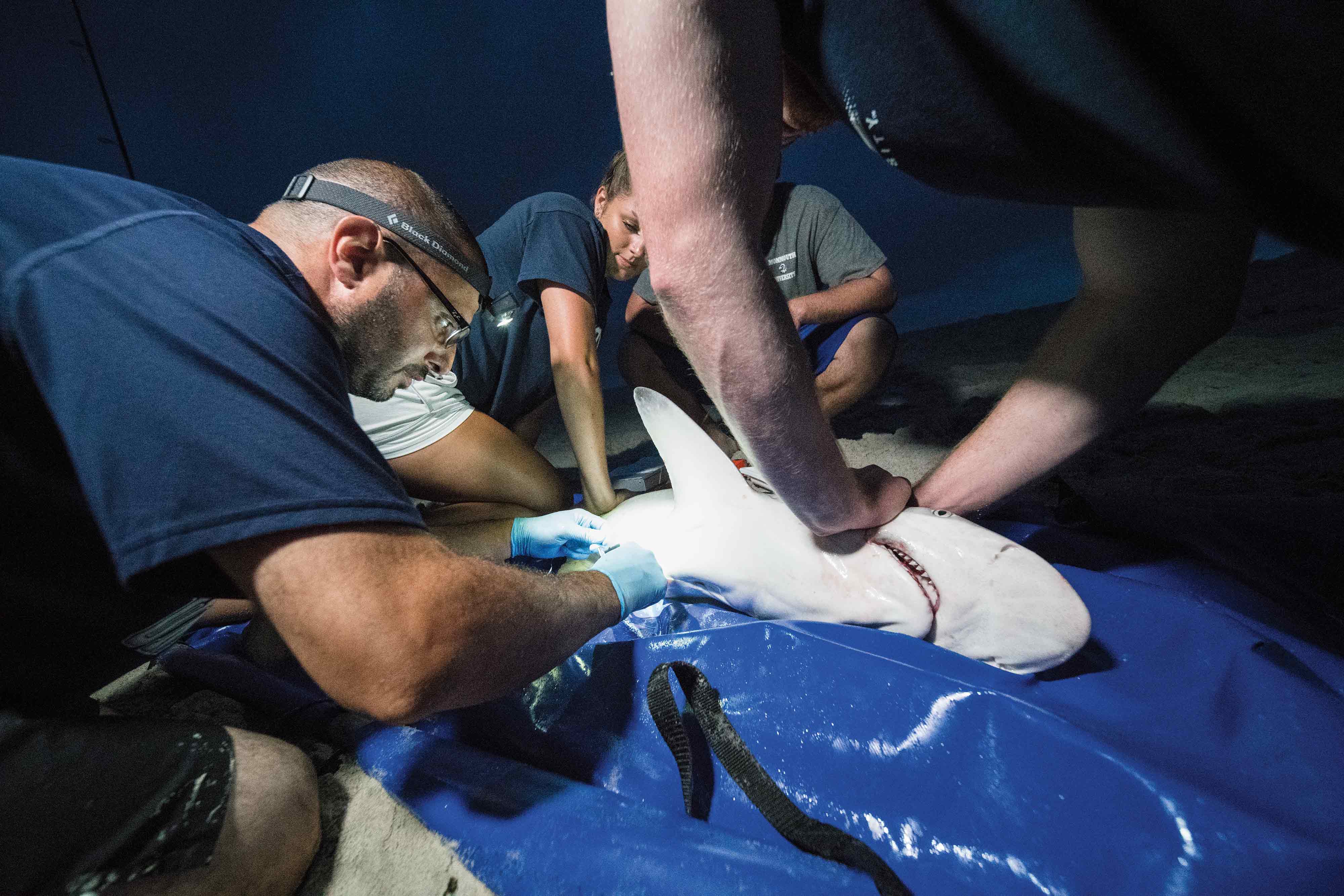
Tag Team
Monmouth researchers are tracking sharks off the coast of New Jersey in an effort to better understand how improper catch and release affects their numbers.
It’s dusk on a Tuesday in the middle of summer and Assistant Professor Keith Dunton and his students are intently eyeing the fishing rods they’ve cast out along the shoreline in Cape May, New Jersey.
It’s been quiet so far, but now that the sun is setting and the warm tide is rolling in, the team is looking to spot a particular pull of the line that signals a potential catch. The smallest tug can indicate to them the difference between a wave rolling out and a bite from what we’ve all come here to see: a shark.
This is the team’s second outing in a week, and since they didn’t catch anything on their first night, the mood is anxious, but hopes are high. As they wait, they chat with the two fishermen from Apex Anglers—experts in landbased shark fishing who are on hand to help—about music, their favorite hiking spots, and shark tales.
Just as dark clouds roll in and the beachgoers begin to recede from their turf, the ticking of a line spurs action.
“Got one!” everyone seems to yell in unison as they jump into overdrive. Dan D’Alessio of Apex gets to the line first. “You have to keep the line firm,” he says. “You can’t have any slack because they’ll have the opportunity to spit the hook.”
The students quickly grab the tools they’ll need: a blue stretcher, measuring tape, scissors, tweezers, a knife, test tubes, an acoustic tag, a dart tag, and a clipboard. If a shark is reeled in, the students will have just a few minutes to tag, measure, and remove parasites from it before release.
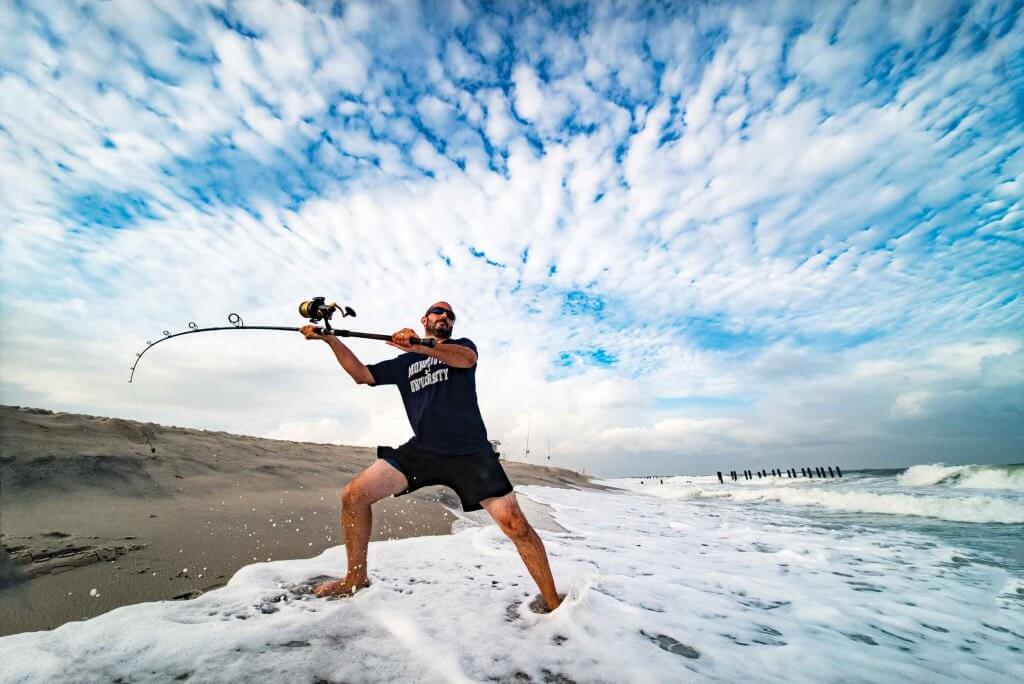
It takes about 90 seconds to haul in what turns out to be a four-foot sandbar shark that puts up a fight, slashing about in the waves. Once it’s close enough, Dunton picks it up briefly to transfer it from the water to the stretcher, walking it a few feet onto the shore, before placing it down gently. The Apex crew removes the hook and stands by for assistance as Dunton begins his work.
He lays the shark on its side as two students firmly hold it down, two hands on the head and two below the dorsal to keep it from biting and squirming. Dunton makes a small incision of two centimeters on its underbelly, where he places a 3.75-inch acoustic tag that he refers to as “E-ZPass for fish.” It will allow him to track the shark’s movements up and down the Atlantic coast for the next decade.
The students make note that this is a female, before their professor flips the shark right-side up to affix a much smaller dart tag, with his contact information on it, just below its dorsal fin. The students measure the shark’s total length and its fork length, which runs from its snout to the point where its tail fin forks inward. Dunton snips a small piece of the pelvic fin for genetic testing and the students scan for parasites, collecting any they can see with the naked eye.
Once done, Dunton and the Apex fishermen carry the shark back out to the water for release. The whole operation lasts about five minutes, and just as quickly as the action came, it’s gone, and the students and their professor settle back down into their beach chairs to wait for the next one.
“I got started in this because land-based fishing for sharks is becoming a hot topic,” says Dunton. “It’s getting a lot of interest right now, especially down in Florida, where there’s a lot of people that fish for sharks from land or piers. They’re catching really big sharks, and certain species suffer higher mortality than others.”
Shark fishing is a big industry, especially in New Jersey, where the winner of the South Jersey Shark Tournament, held off the coast over two to three days, can win a purse of over $300,000. The problem, says Dunton, isn’t necessarily the experienced fishermen. It’s the inexperienced ones who incorrectly “land” sharks, meaning they fish them onto land, often dragging them through the sand and surf zone, and keeping them out of the water for extended periods of time, which can lead to post-release mortality. Because no boat is needed, it’s significantly cheaper and easier for the inexperienced to buy equipment online and fish from land— all that’s needed is a basic saltwater fishing license.
“The problem isn’t the fishermen who are out there all of the time,” says Dunton. “It’s the people that may be on vacation who want to give it a shot by themselves. But the problem is, if you’re not used to catching sharks, what do you do with it if you catch one?”
An inexperienced fisherman may be unable to properly de-hook a shark, leading them to simply cut the line for release, which can leave the shark with a hook in its mouth and sometimes 10 to 20 feet of fishing line behind it. Dragging the shark through the sand can cause damage to its gills, which do not have covers, and keeping it out of water to sit on it and take photos with its mouth open causes stress.
Not to mention, if the hook is improperly set, certain species like the sand tigers—which are gulp feeders—can get the hook lodged in their stomachs.
Dunton says many shark species have suffered population declines due to being caught as by-catch or being harvested for their meat. And because sharks are long-lived and late maturing, an increase in mortality due to improper fishing, combined with these other factors, can be detrimental to a species.
“Some sharks can live to be 60 to 70 years old, and don’t mature until they’re 10 years of age, so if you harvest them, you can really knock out a population,” says Dunton. “So, particularly the sandbar and sand tigers are prohibited because they were harvested in the past.”
An issue that arises with fishing in general, Dunton says, is that you never know what you will catch. It’s up to the angler to be able to spot the difference between species, as some can be harvested for meat and others can’t, and some species, like great hammerheads, are illegal to land at all in certain places.
“One of the prize sharks down in Florida is a great hammerhead. [They’re] critically endangered and they don’t handle stress very well—just the hour fight of catching them, kills them,” says Dunton. “But the theory is that you don’t know if you’re going to catch one, right?”
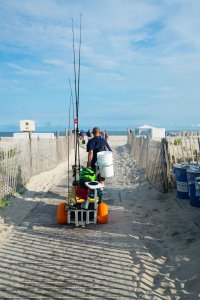
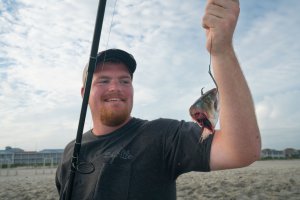
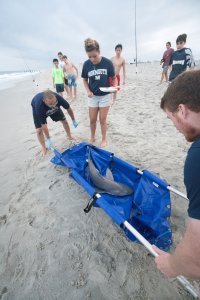
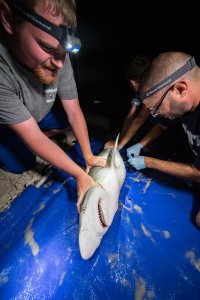
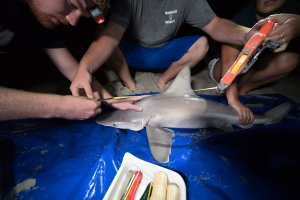
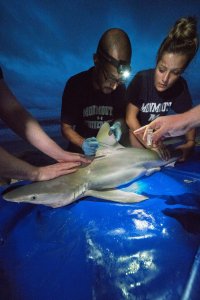
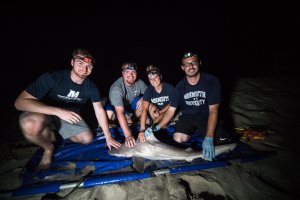
Earlier this year, the Florida Fish and Wildlife Conservation Commission unanimously voted to direct its staff to hold public inquiries and draw up stricter regulations for those seeking to fish sharks from land. One idea being considered is requiring a special license for anglers looking to land sharks.
Dunton says part of the problem when it comes to sharks is that there are many unknowns because they have been largely understudied, leaving scientists without a good handle on how the industry affects various species. This includes sharks that are native to New Jersey, like the sandbar, sand tiger, and dusky shark, all of which are currently prohibited from being harvested.
While NOAA runs the Apex Predator Program in Rhode Island, and OCEARCH tags white sharks along the Atlantic Coast, New Jersey’s coastal sharks have not been largely studied, save for young sharks in the Delaware Bay, a nursery ground for these native coastal species.
To fill this gap, Dunton set out not only to study shark mortality post-release for those sharks fished by conservation-minded fishermen—which provides a minimum mortality estimate—but also to map the demographics as well as spatial and temporal migratory patterns of New Jersey’s coastal sharks.
“Sharks in general don’t get the kind of attention they deserve … no one has really paid attention to what is going on in the coastal areas,” Dunton says. “So, I thought it would be a great opportunity for my students and me.”
Summer 2017 was the first time Dunton and students from Monmouth’s Marine and Environmental Biology and Policy (MEBP) program tagged sharks as part of their summer research project. Partially funded through the School of Science’s biology department and the Urban Coast Institute, Dunton’s students, with help from Apex Anglers, dorsal fin–tagged 53 individual sharks over a 12-week period. Of those tagged, 15 sharks were also surgically implanted with the Vemco V-16-6H acoustic transmitters, which tracked the sharks’ movements for the past year.
“What the transmitter does is, it sends out a unique signal every minute and a half to be picked up by the acoustic receivers that we have placed around the ocean,” says Dunton. “We have 15 to 18 receivers now in Northern New Jersey. We work with the NJDEP, which has receivers close to where we fish in southern New Jersey, so between us we cover at least the span of New Jersey.”
In addition to those receivers, Dunton also has partnerships with various institutions and organizations including the ACT Network, a collaborative group of researchers who share data. The groups have acoustic receivers from Halifax, Nova Scotia, to the Gulf of Mexico, and once or twice a year the researchers pull the data at their respective receivers and send it to Dunton and his students, who then organize it to see the movements of their tagged sharks.
The students this past summer were the first to both tag sharks and interpret a year’s worth of data collected from sharks whose acoustic tags pinged up and down the coast over the last 12 months. What they found was low mortality when sharks are properly fished by experienced anglers. They also found that the larger species, like the sandbars, travel further distances—swimming as far south as North Carolina.
“We’ve realized that we’ve been catching mainly juveniles, so they’re younger, which can be a problem because you don’t want the babies to die—you want them to survive,” says Lauren Kelly, a junior MEBP student. “It seems like the sand tigers are the ones traveling further south than the sandbars and, we caught mostly sandbar females, which is another thing we’re trying to see— why are we catching mostly females?”
This past summer, Dunton, along with his MEBP students, including Kelly, Charlie Vasas and Troy Ohntrup, tagged a total of 54 sharks—18 of which were sandbar sharks that were implanted with acoustic transmitters and will be studied by next summer’s cohort of summer researchers.
For the MEBP students, this was one of their first hands-on experiences in the field doing research.
“I got into this because I love sharks and care about shark conservation,” Vasas says. “I never really had that hands-on experience—I was always just like, ‘I care about shark conservation.’ But now that I’ve actually physically touched the sharks, and brought them on land, and did research and collected data on them, it makes me care even more about them.”
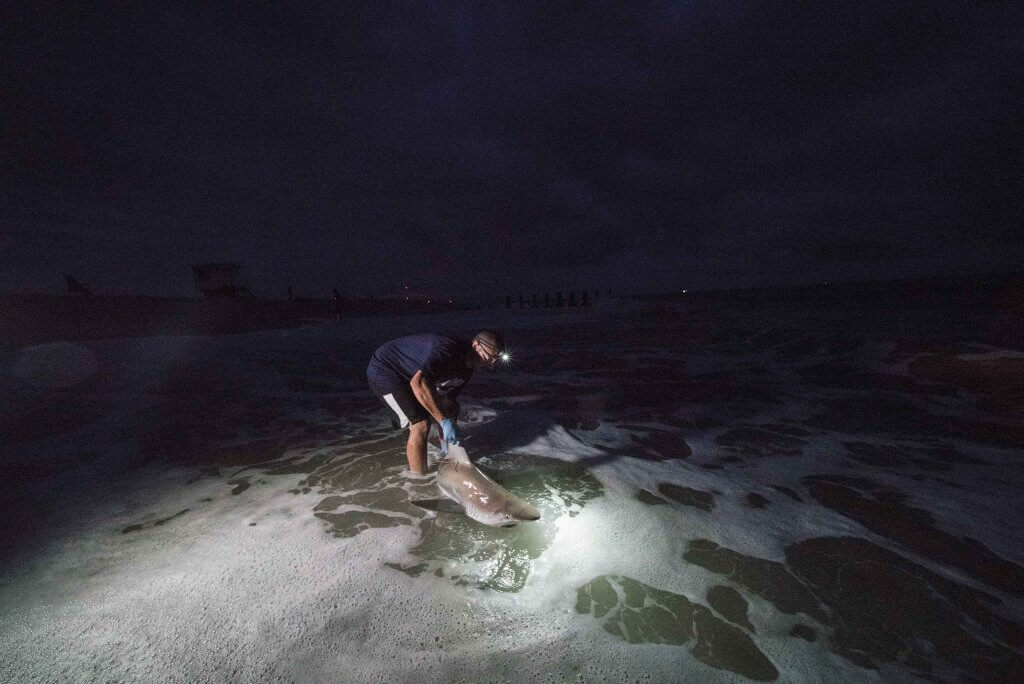
Dunton is steadily building a baseline database of information that will soon include genetic data, which can be cross-referenced with data from the Delaware Bay shark nursery grounds to help determine lineage and population estimates.
All of the information Dunton and his students are compiling can be used to support real-world legislative and policy decisions, like those taking shape in Florida now, with shark conservation in mind.
“In doing this research I wanted to get an idea of what I actually wanted to do with marine biology,” Kelly says. “It was a great experience to be able to see that our work—it’s not like we’re just doing it to do it—it actually means something.”
Next summer, Dunton plans to expand the project to include more local fishermen and hopes to begin working with local bait shops to encourage them to display or hand out brochures with NOAA guidelines, which outline best practices when it comes to shark fishing.
For now, he is looking forward to next season, when he’ll get to work with another set of students who will get to experience for the first time what it’s like to catch a shark.
“Working with the students I find to be amazing, and research like this is always awesome to do because I feel like this one experience can really change the course of their career or life,” says Dunton. “Just to see their pure excitement at seeing their first shark, and then for them to actually work on it and collect samples, is obviously really amazing.”